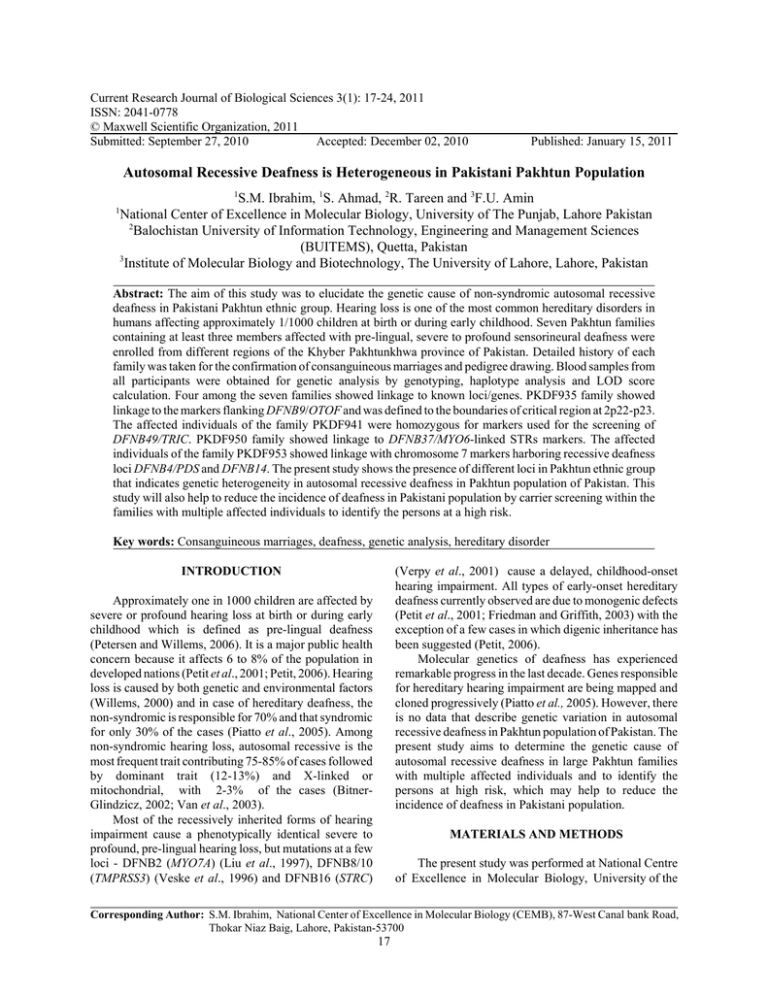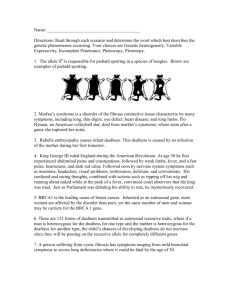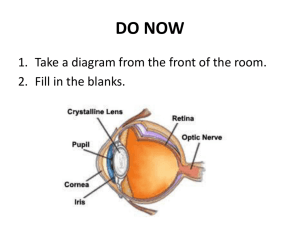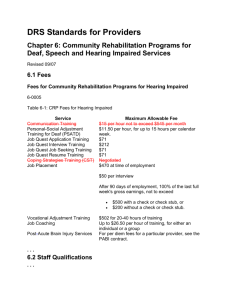Current Research Journal of Biological Sciences 3(1): 17-24, 2011 ISSN: 2041-0778
advertisement

Current Research Journal of Biological Sciences 3(1): 17-24, 2011 ISSN: 2041-0778 © Maxwell Scientific Organization, 2011 Submitted: September 27, 2010 Accepted: December 02, 2010 Published: January 15, 2011 Autosomal Recessive Deafness is Heterogeneous in Pakistani Pakhtun Population 1 S.M. Ibrahim, 1S. Ahmad, 2R. Tareen and 3F.U. Amin National Center of Excellence in Molecular Biology, University of The Punjab, Lahore Pakistan 2 Balochistan University of Information Technology, Engineering and Management Sciences (BUITEMS), Quetta, Pakistan 3 Institute of Molecular Biology and Biotechnology, The University of Lahore, Lahore, Pakistan 1 Abstract: The aim of this study was to elucidate the genetic cause of non-syndromic autosomal recessive deafness in Pakistani Pakhtun ethnic group. Hearing loss is one of the most common hereditary disorders in humans affecting approximately 1/1000 children at birth or during early childhood. Seven Pakhtun families containing at least three members affected with pre-lingual, severe to profound sensorineural deafness were enrolled from different regions of the Khyber Pakhtunkhwa province of Pakistan. Detailed history of each family was taken for the confirmation of consanguineous marriages and pedigree drawing. Blood samples from all participants were obtained for genetic analysis by genotyping, haplotype analysis and LOD score calculation. Four among the seven families showed linkage to known loci/genes. PKDF935 family showed linkage to the markers flanking DFNB9/OTOF and was defined to the boundaries of critical region at 2p22-p23. The affected individuals of the family PKDF941 were homozygous for markers used for the screening of DFNB49/TRIC. PKDF950 family showed linkage to DFNB37/MYO6-linked STRs markers. The affected individuals of the family PKDF953 showed linkage with chromosome 7 markers harboring recessive deafness loci DFNB4/PDS and DFNB14. The present study shows the presence of different loci in Pakhtun ethnic group that indicates genetic heterogeneity in autosomal recessive deafness in Pakhtun population of Pakistan. This study will also help to reduce the incidence of deafness in Pakistani population by carrier screening within the families with multiple affected individuals to identify the persons at a high risk. Key words: Consanguineous marriages, deafness, genetic analysis, hereditary disorder INTRODUCTION (Verpy et al., 2001) cause a delayed, childhood-onset hearing impairment. All types of early-onset hereditary deafness currently observed are due to monogenic defects (Petit et al., 2001; Friedman and Griffith, 2003) with the exception of a few cases in which digenic inheritance has been suggested (Petit, 2006). Molecular genetics of deafness has experienced remarkable progress in the last decade. Genes responsible for hereditary hearing impairment are being mapped and cloned progressively (Piatto et al., 2005). However, there is no data that describe genetic variation in autosomal recessive deafness in Pakhtun population of Pakistan. The present study aims to determine the genetic cause of autosomal recessive deafness in large Pakhtun families with multiple affected individuals and to identify the persons at high risk, which may help to reduce the incidence of deafness in Pakistani population. Approximately one in 1000 children are affected by severe or profound hearing loss at birth or during early childhood which is defined as pre-lingual deafness (Petersen and Willems, 2006). It is a major public health concern because it affects 6 to 8% of the population in developed nations (Petit et al., 2001; Petit, 2006). Hearing loss is caused by both genetic and environmental factors (Willems, 2000) and in case of hereditary deafness, the non-syndromic is responsible for 70% and that syndromic for only 30% of the cases (Piatto et al., 2005). Among non-syndromic hearing loss, autosomal recessive is the most frequent trait contributing 75-85% of cases followed by dominant trait (12-13%) and X-linked or mitochondrial, with 2-3% of the cases (BitnerGlindzicz, 2002; Van et al., 2003). Most of the recessively inherited forms of hearing impairment cause a phenotypically identical severe to profound, pre-lingual hearing loss, but mutations at a few loci - DFNB2 (MYO7A) (Liu et al., 1997), DFNB8/10 (TMPRSS3) (Veske et al., 1996) and DFNB16 (STRC) MATERIALS AND METHODS The present study was performed at National Centre of Excellence in Molecular Biology, University of the Corresponding Author: S.M. Ibrahim, National Center of Excellence in Molecular Biology (CEMB), 87-West Canal bank Road, Thokar Niaz Baig, Lahore, Pakistan-53700 17 Curr. Res. J. Biol. Sci., 3(1): 17-24, 2011 Table 1: STRs markers used for linkage analysis of DFNB4/PDS, DFNB9/OTOF, DFNB37/MYO6 and DFNB49/TRIC locus Locus Markers cM distance DYE PCRprogram PCR conditions Productsize (bp) DFNB4/PDS D7S821 109.12 VIC Julie 54 0.3mlPrimers,1.5mMMgCl2, Spermine 238-270 D7S518 112.32 NED Julie 54 0.2mlPrimers,2.5mMMgCl2, Spermine 179-201 D7S2453 115.96 VIC Julie 54 0.2mlPrimers,1.5mMMgCl2, Spermine 167-199 D7S2420 119.81 FAM Touch-Down 65-55 0.2mlPrimers,2.5mMMgCl2, Spermine 240-292 D7S2459 119.81 VIC Multiplex 52 0.2mlPrimers,2.5mMMgCl2, Spermine 140-152 D7S2456 120.61 NED Julie 54 0.2mlPrimers,2.5mMMgCl2, Spermine 238-252 D7S2847 125.15 NED Julie 54 0.3mlPrimers,2.5mMMgCl2, Spermine, 174-201 D7S480 125.95 FAM Touch-Down 67-57 0.3mlPrimers,2.5mMMgCl2, Spermine 189-206 D7S1842 128.41 FAM Julie 54 0.3mlPrimers, 2.5mMMgCl2 114-154 DFNB9/OTOF D2S305 38.87 NED Multiplex 54 0.1ulPrimer,2.5mM MgCl2 269-283 D2S2150 40.47 VIC Multiplex 54 0.1ulPrimer,2.5mM MgCl2 154-186 D2S174 46.90 NED Multiplex 54 0.2mlPrimers,2.5mMMgCl2 203-221 D2S2144 46.37 FAM Multiplex 54 0.2mlPrimers,2.5mMMgCl2 217-245 D2S165 47.43 FAM Multiplex 54 0.1ulPrimer,2.5mM MgCl2 81-111 DFNB37/MYO6 D6S1031 88.63 NED Touch-Down 65-55 0.4ulPrimer,2.5mMMgCl2,Spermine 251-266 D6S1589 89.23 NED 54 0.4ulPrimer,2.5mMMgCl2 170-188 D6S286 89.83 FAM 54 0.3ulPrimer,1.5 mMMgCl2 206-232 DFNB49/TRIC D5S629 75.89 FAM 57 0.1ulPrimer,2.0mMMgCl2 233-253 GATA141B10 75.89 FAM 54 0.1ulPrimer,2.0mMMgCl2 104-116 D5S637 75.89 FAM 54 0.1ulPrimer,2.0mMMgCl2 246-254 genetics/GeneticResearch/compMaps.asp). The primer sequences for amplification of each marker are listed in the genome database (http://genome.ucsc.edu/cgibin/hgGateway). Genotyping was performed by using ABI PRISM® 3100 Genetic Analyzer. A haplotype representing an individual’s chromosomal segment is the set of genotyped alleles arranged according to the cM distance along a chromosome. Alleles were arranged in ways that confirm the inheritance pattern of segregating disease. Linkage to a particular locus was confirmed when homozygous data of affected members correlated with the disease pattern in the family tree. Punjab, Lahore, Pakistan from January, 2009 to April, 2010. Special children schools in different Pakhtun populated area of Khyber Pakhtunkhwa province, Pakistan were visited and information about the deaf student families was collected. Families with 3 or more affected individuals (with deafness) in 2 or more loops were selected for the study. Informed consent was obtained from participants in study. Detailed history was taken from each family to minimize the presence of other abnormalities and environmental causes for deafness. Families were questioned about skin and hair pigmentation, problems relating to balance, vision, thyroid, kidneys, heart and infectious diseases like meningitis as well as antibiotic usage. Pure tone audiometry with air conduction with 250, 500, 1000, 2000, 4000, 8000 Hz was performed with Siemens, SD-25 or Beltone 112 audiometer. Pedigrees of the enrolled families were drawn using Cyrillic® program for Windows. Genomic DNA was extracted from the blood samples following an inorganic method (Grimberg et al., 1989). Plate map was designed that consisted of all the affected individuals with parents and normal siblings from the family. Replicates of the designed master plate were made with 50 ng of DNA for linkage studies and overlaid with 10 mL mineral oil. LOD score calculations: Two-point LOD scores were calculated for deafness linked markers by using EASYLINKAGE software as described by Ott (1991) and Terwillger and Ott (1994). Deafness was assumed to be inherited in an autosomal recessive manner with complete penetrance. Recombination frequencies were assumed to be equal in both males and females. Genetic distances were based on Marshfield human genetic map. RESULTS Seven Pakhtun families with a history of deafness and recessive mode of inheritance were collected from different areas of KP (Khyber Pakhtunkhwa Province: Formerly known as NWFP). All affected members of these families had pre-lingual, severe to profound sensorineural deafness. Physical and clinical evaluation was performed to rule out any extra-auditory phenotype. Detailed medical history was taken to exclude environmental causes. Written informed consent was obtained from all participants. These families were screened for known deafness loci through linkage analysis Haplotype analysis: Families were screened for all the microsatellite markers for the characterization of autosomal recessive deafness. Here only the linked markers (Table 1) were used for haplotype analysis. All the markers for linkage analysis were dinucleotide repeats except D7S821, D7S2847, D7S1842, GATA141B10 (Tetra repeats), and D6S1031 (Tri repeat) and were chosen from the Marshfield Comprehensive Human Genetic Maps (http://research.marshfieldclinic.org/ 18 Curr. Res. J. Biol. Sci., 3(1): 17-24, 2011 Fig. 1: Pedigree drawing of PKDF935 showing linkage to DFNB9/OTOF haplotype analysis, it was found that all deaf individuals were homozygous for all above mentioned markers flanking DFNB9. The haplotype analysis showed 8.56cM linkage interval, delineated by markers, D2S305 (38.87cM), which lies above the gene and D2S165 (47.43cM), locating below the gene. Among the phenotypically normal individuals, individuals, III:5, III:6, III:9, IV:9, and IV:10 were carrier for the diseased haplotype, while individuals IV: 2, and VI: 7 were phenotypically and genotypically normal (Fig. 1). The two-point LOD score calculation for the family data produced a maximum LOD score (Zmax) of 2.8619 with marker D2S2144 (46.37cM). and four families PKDF935, PKDF941, PKDF950 and PKDF953, showed linkage to four different genes/loci DFNB9/OTOF, DFNB49/TRIC, DFNB37/MYO6, and DFNB4/PDS/DFNB14, respectively. Medical profile of the affected individuals: Physical and clinical evaluation of all the affected individuals ruled out the syndromic as well as environmental causes of deafness in these families. Affected individuals had no signs of goiter, night blindness, balance problems, diabetes, and mental retardation along with deafness indicating segregation of non-syndromic deafness in all the enrolled families. Tandem gait test was performed to rule out balance dysfunction in affected individuals. PKDF941: Highly inbred pedigree PKDF941 enrolled from district Malakand belongs to Pakhtun background. PKDF941 consists of six affected individual in two loops (Fig. 2). Pedigree was drawn by consulting several members of the family to confirm the consanguinity. The ages of the affected individuals (V: 1, V: 2 V: 3, V: 6, V: 7, and V: 8) were 17, 10, 15, 10, 25, and 9 at the time of enrolment. All the affected members displayed progressive hearing loss. PKDF935: This family was a large consanguineous family enrolled from district Malakand, KP (Fig. 1). This family belonged to the Musha Khail caste with Pakhtun ethnicity. Detailed pedigree was drawn after interviewing multiple members of the family. The pedigree consists of three affected individuals (IV: 5, IV: 6, and IV: 8) (two female and one male) having congenital hearing loss. At the time of enrolment blood of three deaf and seven normal individuals were collected. Linkage analysis: Haplotype analysis revealed that all affected individuals (V: 1, V: 2, V: 3, V: 6, V: 7, and V: 8) were homozygous for markers, D5S629 (75.89cM), GATA141B10 (75.89cM), and D5S637 (75.89cM) used for the screening of DFNB49/TRIC. The individuals V: 4, V: 11, V: 14, IV: 1, IV: 6 and IV: 7 were phenotypically normal but genetically carrier for the disease allele and Linkage analysis: After screening, the family showed linkage to the markers flanking DFNB9/OTOF. To define the boundaries of critical region at 2p22-p23, a set of five STRs markers, D2S305 (38.87cM), D2S2150 (40.47cM), D2S2144 (46.37cM), D2S174 (46.90cM), and D2S165 (47.43cM) were genotyped in the family. From the 19 Curr. Res. J. Biol. Sci., 3(1): 17-24, 2011 Fig. 2: Pedigree drawing of PKDF941showing linkage to DFNB49/TRIC Fig. 3: Pedigree drawing of PKDF950 showing linkage to DFNB37/MYO6 20 Curr. Res. J. Biol. Sci., 3(1): 17-24, 2011 Fig. 4: Pedigree drawing of PKDF953 showing linkage to DFNB4/SLC26A4 and DFNB14 at chromosome 7 haplotype and the individuals VI: 8, V: 3, V: 4 and V: 7 were phenotypically normal, but were found genetically carrier (Fig. 3). The individuals VI: 2, VI: 3, VI: 10 and VI: 12 showed no linkage and were found normal both phenotypically and genotypically. A maximum two-point LOD score (Zmax) of 3.1159 was obtained for marker D6S286 (89.83cM). the individuals V: 12 and V: 13 were found normal both phenotypically and genotypically (Fig. 2). Two-point LOD score was calculated for family that yielded a maximum LOD score (Zmax) of 4.0280 for marker D5S637 (75.89cM). PKDF950: This consanguineous family, PKDF950 ascertained from “Mardan” belongs to caste “Uthman Khail” Pakhtun. It consists of four affected individuals (VI: 1, VI: 7, VI: 9 VI: 11) in two loops (Fig. 3). Blood samples of deaf individuals, normal and their parents were taken with their consent at the time of enrolment. PKDF953: This was a consanguineous Madoo Khail (Pakhtun) family enrolled from district Dir Lower containing five affected individuals in two loops (Fig. 4). Blood samples of five deaf and seven normal individuals were taken with their consent at the time of enrolment. The affected individuals (VI: 4, VI: 5, VI: 7, VI: 13 and VI: 14) aged 11, 6, 24, 22 and 18 years, respectively at the time of enrollment. Linkage analysis: Linkage analysis to known loci was performed by genotyping three microsatellite markers. Four deaf and eight normal individuals of two loops were included in the linkage study. All affected individuals showed linkage to DFNB37/MYO6-linked STRs markers, D6S1031 (88.63cM), D6S1589 (89.23cM), and D6S286 (89.83cM). All deaf were homozygous for the diseased Linkage analysis: During screening, all the affected individuals of PKDF953 showed linkage with chromosome 7 markers harboring two recessive deafness 21 Curr. Res. J. Biol. Sci., 3(1): 17-24, 2011 Another consanguineous family, PKDF935, with five affected individuals in two loops was found linked with DFNB9/OTOF. DFNB9/OTOF was mapped first time in a large consanguineous Lebanese family through genomewide linkage analysis at chromosome 2p23-p22 (Chaïb et al., 1996). Mutations of OTOF account for hereditary deafness in diverse populations (Yasunaga et al., 1999; Houseman et al., 2001; Leal et al., 1998; Mirghomizadeh et al., 2002; Migliosi et al., 2002). DFNB9/OTOF is infrequent cause of deafness in Pakistani population with 557 families screened, only 13 showed linkage to DFNB9/OTOF, thus contributing only 2.3% (Choi et al., 2009). A large inbred Pakhtun family from district Mardan, PKDF950, with four affected individuals in two loops showed linkage with DFNB37/MYO6. DFNB37 locus was first identified in a large consanguineous Pakistani family with profound, sensorineural, pre-lingual hearing loss that co-segregated at 6q13 (Ahmed et al., 2003). The linkage region included the MYO6 gene encoding myosin VI and which was previously found to be responsible for an autosomal-dominant form of post-lingual progressive deafness (DFNA22) in Italian kindred (Melchionda et al., 2001). Up till now, three recessive MYO6 mutations (36-37insT, 3496C÷T, and E216V) have been identified in Pakistani families (Ahmed et al., 2003). DFNB37/MYO6 is a rare cause of deafness in Pakistani population. DFNB49, a recessive hearing disorder, was first mapped in two large Pakistani families at chromosome 5q13 (Ramzan et al., 2005). Mutations within the TRIC gene, which encodes tricellulin, are responsible for DFNB49 hearing loss (Riazuddin et al., 2006). Tricellulin is a tricellular tight-junction (tTJ) protein, which is key in the formation of barriers between tricellular contacts of epithelial cells throughout the body (Ikenouchi et al., 2005). A large consanguineous family PKDF941 from district Malakand with six affected individuals in two loops was found linked with three microsatellite markers D5S629 (75.89cM), GATA141B10 (75.89cM) and D5S637 (75.89cM) used for screening of DFNB49/TRIC. The relative contribution of DFNB49 in Pakistani deaf population is approximately 1.06%, a significant proportion considering the extensive genetic heterogeneity of deafness in this population (Chishti et al., 2008). loci (DFNB4/PDS and DFNB14). Additional STR markers were genotyped to confine the linkage interval and define the proximal and distal boundaries. Haplotype analysis defined the proximal breakpoint at D7S821 (109.12cM) in affected individual (VI: 4 and VI: 5) and D7S2847 (125.15cM) defined the distal breakpoint in affected individual (VI: 13) (Fig. 4). These two meiotic recombinations define a critical linkage interval of 16.03cM. Unaffected individuals (III: 5, III: 6, V: 1, VI: 2, VI: 3, VI: 6, and VI: 9) were phenotypically normal and genetically carrier for the diseased allele. A maximum two-point LOD score (Zmax) of 3.9748 was obtained for marker D7S2459 (119.81cM). DISCUSSION A large number of genes are anticipated to be responsible for controlling the anatomic and physiologic function of the ear (Friedman and Griffith, 2003). Phenotypically, hearing impairment is classified as syndromic and non-syndromic. Non-syndromic forms of deafness transmitted as a recessive trait are the most common cause of hereditary hearing loss and often exhibit the most severe hearing phenotype (Cohen and Gorlin, 1995). Non-syndromic autosomal recessive deafness is usually clinically homozygous and is progressive in nature (Van-Camp et al., 1997). Recessive deafness is more prevalent in endogenous and isolated populations (Friedman and Griffith, 2003) and Pakistan represents a true treasure for molecular dissection of hearing disorder because 60% marriages are consanguineous and out of those approximately 80% are between first cousins (Hussain and Bittles, 1998). DFNB4/PDS is the most common locus in Pakistani population with the prevalence of 7.2% (Anwar et al., 2009). One large consanguineous family, PKDF953, with profound hearing loss was found linked with DFNB4/PDS and DFNB14 with significant two-point LOD scores of 3.9748 and 3.0788 for markers D7S2459 and D7S518. Ages of all the affected individuals were below thirty and they showed no signs of goiter. Mutational analysis is required to find out whether this family is linked with DFNB4 or DFNB14. Further more, if the affected individuals develop goiter later in their life (above thirty years), then it would be confirmed that the hearing loss is syndromic and is inherited as recessive. DFNB4 was first described in a deaf Israeli Druze family with pre-lingual, severe deafness and found linked to a 5-cM region on human chromosome 7 (Baldwin et al., 1995). Mutant alleles of SLC26A4 are responsible for non-syndromic, DFNB4 (Li et al., 1998), Pendred syndrome (Everett et al., 1997) as well as Enlarged Vestibular Aqueduct (EVA) syndrome (Usami et al., 1999). SLC26A4 mutations account for approximately 10% of hereditary deafness in diverse populations that include eastern and southern Asians (Park et al., 2003). CONCLUSION The presence of different genes/loci associated with autosomal recessive deafness in Pakhtun ethnic group indicates genetic heterogeneity. DFNB4/PDS is the most common locus in Punjabi ethnic group and it is expected that it might be the most frequent locus present in Pakhtun ethnic group as well, but needs to be further investigated. The benefit of this study is to reduce the incidence of 22 Curr. Res. J. Biol. Sci., 3(1): 17-24, 2011 Choi, B.Y., Z.M. Ahmed, S. Riazuddin, M.A. Bhinder, M. Shahzad, T. Husnain, S. Riazuddin, A.J. Griffith and T.B. Friedman, 2009. Identities and frequencies of mutations of the otoferlin gene (OTOF) causing DFNB9 deafness in Pakistan. Clin. Genet., 75(3): 237-243. Cohen, M.M. and R.J. Gorlin, 1995. Epidemiology, Etiology and Genetic Patterns. In: Gorlin, R.J., H.V. Toriello and M.M. Cohen, (Eds.), Hereditary Hearing Loss and its Syndromes. Oxford University Press, pp: 43-61. Everett, L.A., B. Glaser, J.C. Beck, J.R. Idol, A. Buchs, M. Heyman, F. Adawi, E. Hazani, E. Nassir, A.D. Baxevanis, V.C. Sheffield and E.D. Green, 1997. Pendred syndrome is caused by mutations in a putative sulphate transporter gene (PDS). Nat. Genet., 17: 411-422. Friedman, T.B. and A.J. Griffith, 2003. Human nonsyndromic sensorineural deafness. Ann. Rev. Genom. Hum. Genet., 4: 341-402. Grimberg, J., S. Nawoschik, L. Belluscio, R. McKee, A. Turck, and A. Eisenberg, 1989. A simple and efficient non-organic procedure for the isolation of genomic DNA from blood. Nucleic Acids Res., 17: 83-90. Houseman, M.J., A.P. Jackson, L.I. Al-Gazali, R.A. Badin, E. Roberts and R.F. Mueller, 2001. A novel mutation in a family with non-syndromic sensorineural hearing loss that disrupts the newly characterised OTOF long isoforms. J. Med. Genet., 38: e25. Hussain, R. and A.H. Bittles, 1998. The prevalence and demographic characteristics of consanguineous marriages in Pakistan. J. Biosoc. Sci., 30: 261-275. Ikenouchi, J., M. Furuse, K. Furuse, H. Sasaki, S. Tsukita and S. Tsukita, 2005. Tricellulin constitutes a novel barrier at tricellular contacts of epithelial cells. J. Cell Biol., 171: 939-945. Leal S.M., F. Apaydin, C. Barnwell, M. Iber, T. Kandogan, M. Pfister, U. Braendle, M. Cura, H.P. Zenner and E. Vitale, 1998. A second Middle Eastern kindred with autosomal recessive nonsyndromic hearing loss segregates DFNB9. Eur. J. Hum. Genet., 6: 341-344. Li, X.C., L.A. Everett, A.K. Lalwani, D. Desmukh, T.B. Friedman, E.D. Green and E.R. Wilcox, 1998. A mutation in PDS causes non-syndromic recessive deafness. Nat. Genet., 18: 215-217. Liu, X.Z., J. Walsh, P. Mburu, J. Kendrick-Jones, M.J.T.V. Cope, K.P. Steel and S.D.M. Brown, 1997. Mutations in the myosin VIIA gene cause nonsyndromic recessive deafness. Nat. Genet., 16: 188-190. deafness in Pakistani population by providing knowledge and awareness through carrier screening within the families with multiple affected individuals to identify the persons at a high risk. Marriages within the family are quite common in Pakistan, therefore identification of carriers, increasing awareness about the possible effects of consanguineous families, offering the genetic counseling and prenatal diagnosis to the families can help to reduce the incidence of hereditary deafness in our population. For obtaining this objective, the need is to further characterize the deafness at molecular level and identify the particular genes/loci that contribute most to hearing loss in the concerned population. ACKNOWLEDGMENT Authors are deeply grateful to Mr. Abrar H. Khan (Research Scholar at CEMB, University of the Punjab) for the critical evaluation of this manuscript. REFERENCES Ahmed, Z.M., R.J. Morell, S. Riazuddin, A. Gropman, S. Shaukat, M.M. Ahmad, S.A. Mohiddin, L. Fananapazir, R.C. Caruso, T. Husnain, S.N. Khan, S. Riazuddin, A.J. Griffith, T.B. Friedman and E.R. Wilcox, 2003. Mutations of MYO6 are associated with recessive deafness, DFNB37. Am. J. Hum. Genet., 72: 1315-1322. Anwar, S., S. Riazuddin, Z.M. Ahmed, S. Tasneem, Ateeq-ul-Jaleel, S.Y. Khan, A.J. Griffith, T.B. Friedman and S. Riazuddin, 2009. SLC26A4 mutation spectrum associated with DFNB4 deafness and Pendred's syndrome in Pakistanis. J. Hum. Jenet., 54: 266-270. Baldwin, C.T., S. Weiss, L.A. Farrer, A.L.D. Stefano, R. Adair, B. Franklyn, K.K. Kidd, M. Korostishevsky and B. Bonné-Tamir, 1995. Linkage of congenital, recessive deafness (DFNB4) to chromosome 7q31 and evidence for genetic heterogeneity in the Middle Eastern Druze population. Hum. Mol. Genet., 4: 1637-1642. Bitner-Glindzicz, M., 2002. Hereditary deafness and phenotyping in humans. Br. Med. Bull., 63: 73-94. Chaïb, H., C. Place, N. Salem, S. Chardenoux, C. Vincent, J. Weissenbach, E. El-Zir, J. Loiselet and C. Petit, 1996. A gene responsible for a sensorineural non-syndromic recessive deafness maps to chromosome 2p22-23. Hum. Mol. Genet., 5: 155-158. Chishti, M.S., A. Bhatti, S. Tamim, K. Lee, M. McDonald, S.M. Leal and W. Ahmad, 2008. Splice-site mutations in the TRIC gene underlie autosomal recessive nonsyndromic hearing impairment in Pakistani families. J. Hum. Genet., 53(2): 101-105. 23 Curr. Res. J. Biol. Sci., 3(1): 17-24, 2011 Melchionda, S., N. Ahituv, L. Bisceglia, T. Sobe, F. Glaser, R. Rabionet, M.L. Arbones, A. Notarangelo, E.D. Iorio, M. Carella, L. Zelante, X. Estivill, K.B. Avraham, and P. Gasparini, 2001. MYO6, the human homologue of the gene responsible for deafness in Snell’s waltzer mice, is mutated in autosomal dominant nonsyndromic hearing loss. Am. J. Hum. Genet., 69: 635-640. Migliosi, V., S. Modamio-Heybjer, M.A. Moreno-Pelayo, M. Rodriguz-Ballesteros, M. Villamar, D. Telleria, I. Menendez, F. Moreno, and I.D. Castillo, 2002. Q829X, a novel mutation in the gene encoding otoferlin (OTOF), is frequently found in Spanish patients with prelingual non-syndromic hearing loss. J. Med. Genet., 39: 502-506. Mirghomizadeh, F., M. Pfister, F. Apaydin, C. Petit, S. Kupka, C.M. Pusch, H.P. Zenner, and N. Blin, 2002. Substitutions in the conserved C2C domain of otoferlin cause DFNB9, a form of nonsyndromic autosomal recessive deafness. Neurobiol. Dis., 10: 157-164. Ott, J., 1991. Analysis of Human Genetic Linkage. Johns Hopkins University Press. Park, H.J., S. Shaukat, X.Z. Liu, S.H. Hahn, S. Naz, M. Ghosh, H.N. Kim, S.K. Moon, S. Abe, K. Tukamoto, S. Riazuddin, M. Kabra, R. Erdenetungalag, J. Radnaabazar, S. Khan, A. Pandya, S.I. Usami, W.E. Nance, E.R. Wilcox, S. Riazuddin and A.J. Griffith, 2003. Origins and frequencies of SLC26A4 (PDS) mutations in East and South Asians: global implications for the epidemiology of deafness. J. Med. Genet., 40: 242-248. Petersen, M.B. and P.J. Willems, 2006. Non-syndromic, autosomal-recessive Deafness. Clin. Genet., 69: 371-392. Petit, C., 2006. From deafness genes to hearing mechanisms: Harmony and counterpoint. Tre. Mol. Med., 12: 57-64. Petit, C., J. Levilliers and J.P. Hardelin, 2001. Molecular genetics of hearing loss. Ann. Rev. Genet., 35: 589-646. Piatto, V.B., E.C.T. Nascimento, F. Alexandrino, C.A. Oliveira, A.C.P. Lopes, E.L. Sartorato and J.V. Maniglia, 2005. . Molecular genetics of nonsyndromic deafness. Rev. Bras. Otorrinolaringol., 71(2): 216-223. Ramzan, K., R.S. Shaikh, J. Ahmad, S.N. Khan, S. Riazuddin, Z.M. Ahmed, T.B. Friedman, E.R. Wilcox and S. Riazuddin, 2005. A new locus for nonsyndromic deafness DFNB49 maps to chromosome 5q12.3-q14.1. Hum. Genet., 116: 17-22. Riazuddin, S., Z.M. Ahmed, A.S. Fanning, A. Lagziel, S. Kitajiri, K. Ramzan, S.N. Khan, P. Chattaraj, P.L. Friedman, J.M. Anderson, I.A. Belyantseva, A. Forge, S. Riazuddin and T.B. Friedman, 2006. Tricellulin is a tight-junction protein necessary for hearing. Am. J. Hum. Genet., 79(6): 1040-1051. Terwillger, J.D. and J. Ott, 1994. Handbook of Human Genetic Linkage. Baltimore, Johns Hopkins University Press. Usami, S., S. Abe, M.D. Weston, H. Shinkawa, G. VanCamp and W.J. Kimberling, 1999. Non-syndromic hearing loss associated with enlarged vestibular aqueduct is caused by PDS mutations. Hum. Genet., 104: 188-192. Van, L.L., K. Cryns, R.J. Smith and G. Van-Camp, 2003. Nonsyndromic hearing loss. Ear Hear., 24: 275-288. Van-Camp, G., P.J. Willems and R.J.H. Smith, 1997. Nonsyndromic hearing impairment unparalleled heterogeneity. Am. J. Hum. Genet., 60: 758-764. Verpy, E., S. Masmoudi, I. Zwaenepoel, M. Leibovici, T.P. Hutchin, I.D. Castillo, S. Nouaille, S. Blanchard, S. Lainé, J.L. Popot, F. Moreno, R.F. Mueller and C. Petit, 2001. Mutations in a new gene encoding a protein of the hair bundle cause non-syndromic deafness at the DFNB16 locus. Nat. Genet., 29: 345-349. Veske, A., R. Oehlmann, F. Younus, A. Mohyuddin, B. Muller-Myhsok, S.Q. Mehdi and A. Gal, 1996. Autosomal recessive non-syndromic deafness locus (DFNB8) maps on chromosome 21q22 in a large consanguineous kindred from Pakistan. Hum. Mol. Genet., 5: 165-168. Willems, P.J., 2000. Genetic causes of hearing loss. N. Engl. J. Med., 342: 1101-1109. Yasunaga, S., M. Grati, M. Cohen-Salmon, A. El-Amraoui, M. Mustapha, N. Salem, E. El-Zir, J. Loiselet and C. Petit, 1999. A mutation in OTOF, encoding otoferlin, a FER-1-like protein, causes DFNB9, a nonsyndromic form of deafness. Nat. Genet., 21: 363-369. 24





